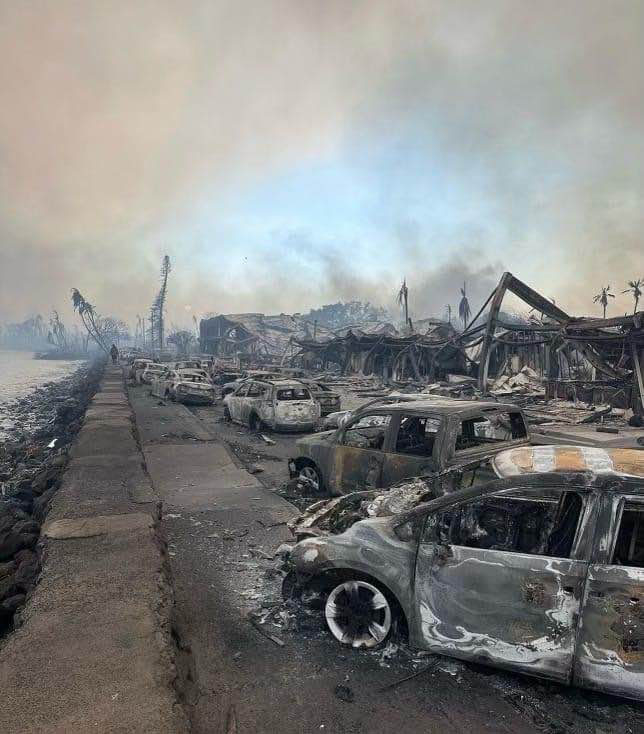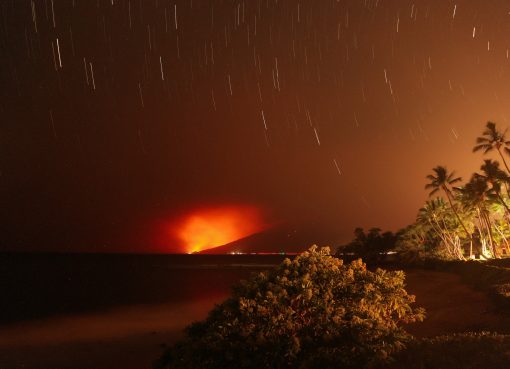Lahaina Fires: Why Looking Back Matters

On August 8, 2023, Hurricane Dora, a Category 4 storm, swept through the middle Pacific 800 miles southwest of Honolulu. (Calfas, 2023) The storm did not bring much rain, but 60-mile-per-hour winds hit the Hawaiian Islands, knocking down powerlines and trees and igniting wildfires across three islands. (Hawaii Fire, 2023) By the end of the day, those wildfires charred 2,170 acres in the West Maui town of Lahaina (Maui Police Department, 2024) and killed 100 people, making it one of the deadliest wildfires in U.S. history. (Baker & Bogel-Burroughs, 2024) (Piper et al., n.d.)
Wildfires are not a novelty in Hawaii. About 0.48% of Hawaii’s total land area burns annually, greater proportionally than the United States mainland (0.30%) and the 12 most fire-prone mainland states (0.46%). (Williams, 2021) On August 6, the National Weather Service issued a red alert for the area, and on August 7, the Maui Police Department (MPD) partially opened its EOC due to the red alert and high winds. (“Hawaiian Energy Officials Testify on Maui Wildfires | C-SPAN.Org,” 2023)
The generally accepted cause of the initial August 8 fire in Lahaina¹ was downed electric wires igniting vegetation in an unmanaged plot of land north of the residential area (Piper et al., n.d.). However, the seeds of the crisis were planted long before August 8.
Failures at Every Level
Using the Swiss Cheese Model, we can see that there were failures at each level of control (Swiss Cheese Model, n.d.).
First, engineering controls failed. Some 57 percent of the electrical lines in Hawaii are above ground (Undergrounding et al.), and those lines often were (and continue to be) held by old, wooden, termite-damaged poles. At least 29 of these poles fell across West Maui roads on August 8 (Hill, 2023), igniting fires and preventing safe evacuations. In the years prior to the fire, HECO spent millions less to replace tens of thousands of at-risk utility poles than it had planned. (Frosch, 2023)
Administrative controls also failed. Despite numerous warnings, Maui had weak code enforcement and limited government resources to compel meaningful behaviors to manage the wildfire risks. (Piper et al., n.d.) On Oahu, regulations require that powerlines built for residences after 1966 be underground, but no such regulations exist for the other islands in the state. The fallen powerlines were fully energized on August 8 despite the wind warnings because, according to HECO, shutting off the power in Lahaina would have required “coordinating with first responders.” (Hill, 2023)
Behavioral controls also failed long before August 8. The fields surrounding Lahaina are no longer wetlands nor fields growing crops like sugar or pineapple (Calfas, 2023). Instead, they grow highly flammable invasive grasses that landowners have allowed to grow without maintenance, protective barriers, or irrigation (Piper et al., n.d.).
Mitigating barriers also failed due to actions and decisions made long before the fire broke out. On August 8, many residents did not receive the alert to evacuate on their mobile phones because wireless emergency notifications relied on a cell phone network that relies on above-ground fiber infrastructure, which burned and failed. (Baker, Olmos, et al., 2023)
Lahaina Fire Emergency Communications
In this scene set for disaster, lives depended on getting helpful information to the residents and visitors in Lahaina on August 8. However, many Lahaina residents said they were not alerted, leaving them racing to escape as the fire roared toward their homes (Baker et al., 2023). Only two Lahaina neighborhoods were sent alerts via mobile phone that day, and many who were sent alerts never got it. Those who did get the alert on their phones or saw or smelled smoke, often turned to AM/FM radio or television, where they saw no warnings or alerts — only regular programming. (Baker, Olmos, et al., 2023)
The Lahaina Fires series will take an in-depth look at the communications to examine:
- How effective were the crisis communications sent on August 8?
- Where did communicators need more best practices and guidance?
- What issues might explain what caused errors and confusion along the way?
This series will address the questions above by examining the crisis communications created by the two government agencies at the center of the response to the Lahaina fires: the Maui Emergency Management Agency (MEMA) and the County of Maui. It will look at the 20 unique communications these government agencies disseminated to the public as individual pieces and collectively against best practices and guidelines for crisis communications and draw on the analysis to propose solutions to improve communication effectiveness in future crises.
Author’s Note
In the Spring of 2024, I conducted an in-depth study on the 2023 Lahaina fire disaster for my final project in the Emergency Management course at the Kennedy School of Government at Harvard University. The Lahaina Fires engulfed the entire town, claimed numerous lives, and left a profound impact and will for generations to come. The tragedy also taught us and reinforced lessons that, when acted upon, can save many more lives in the future. My intent for sharing my findings is not to dwell on where the blame lies but instead to go forward with the gift of knowledge for which we paid so heavy of a price. — Jill Byus Radke
¹ Fires burned in other areas of Maui County on August 8, 2023. Multiple evacuations were conducted across the state, but the wildfires were geographically distinct, with mountains and miles separating them. For focus, the Lahaina Fires series will focus on the communications about the Lahaina afternoon fires from approximately 3 p.m. to midnight.



